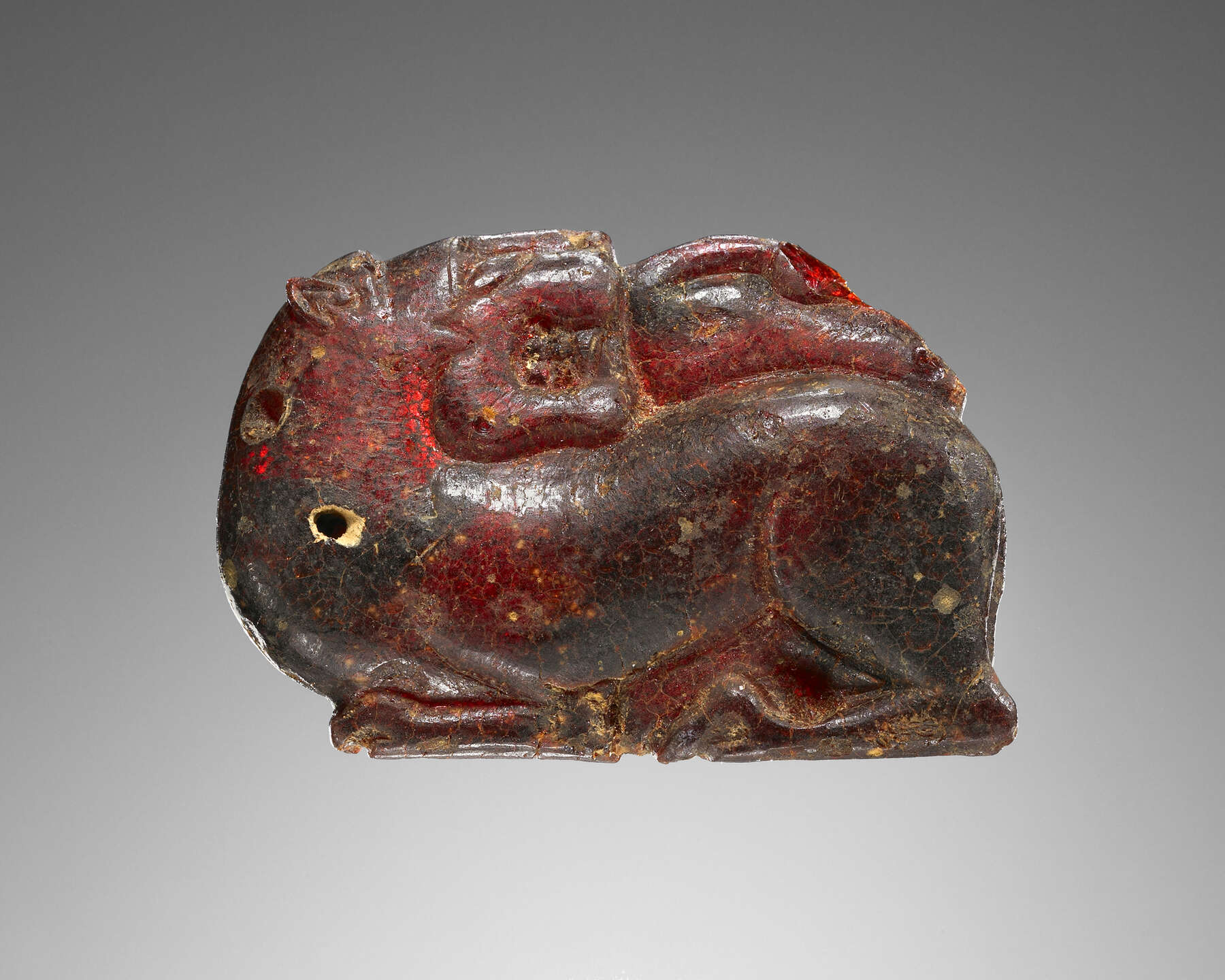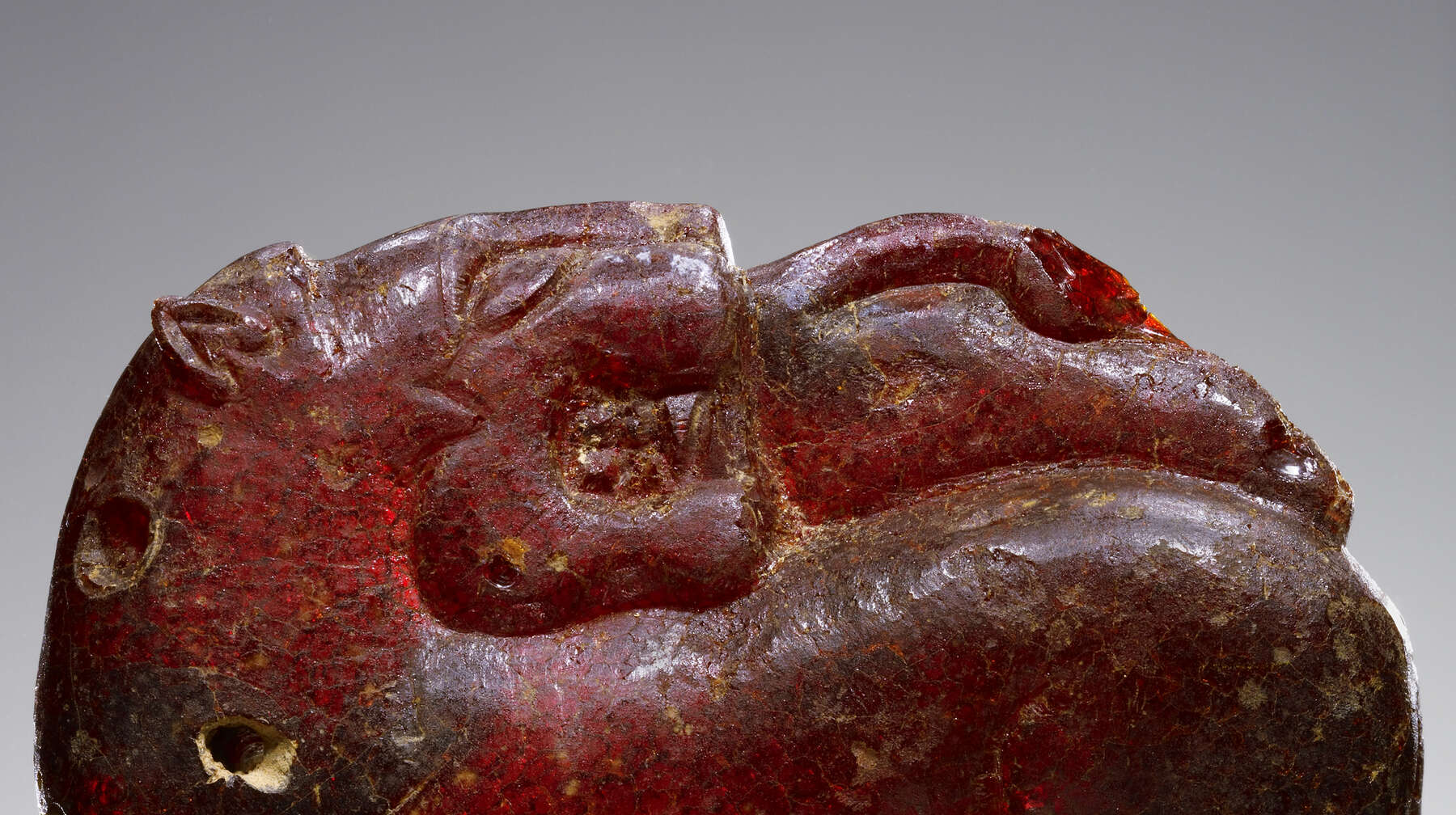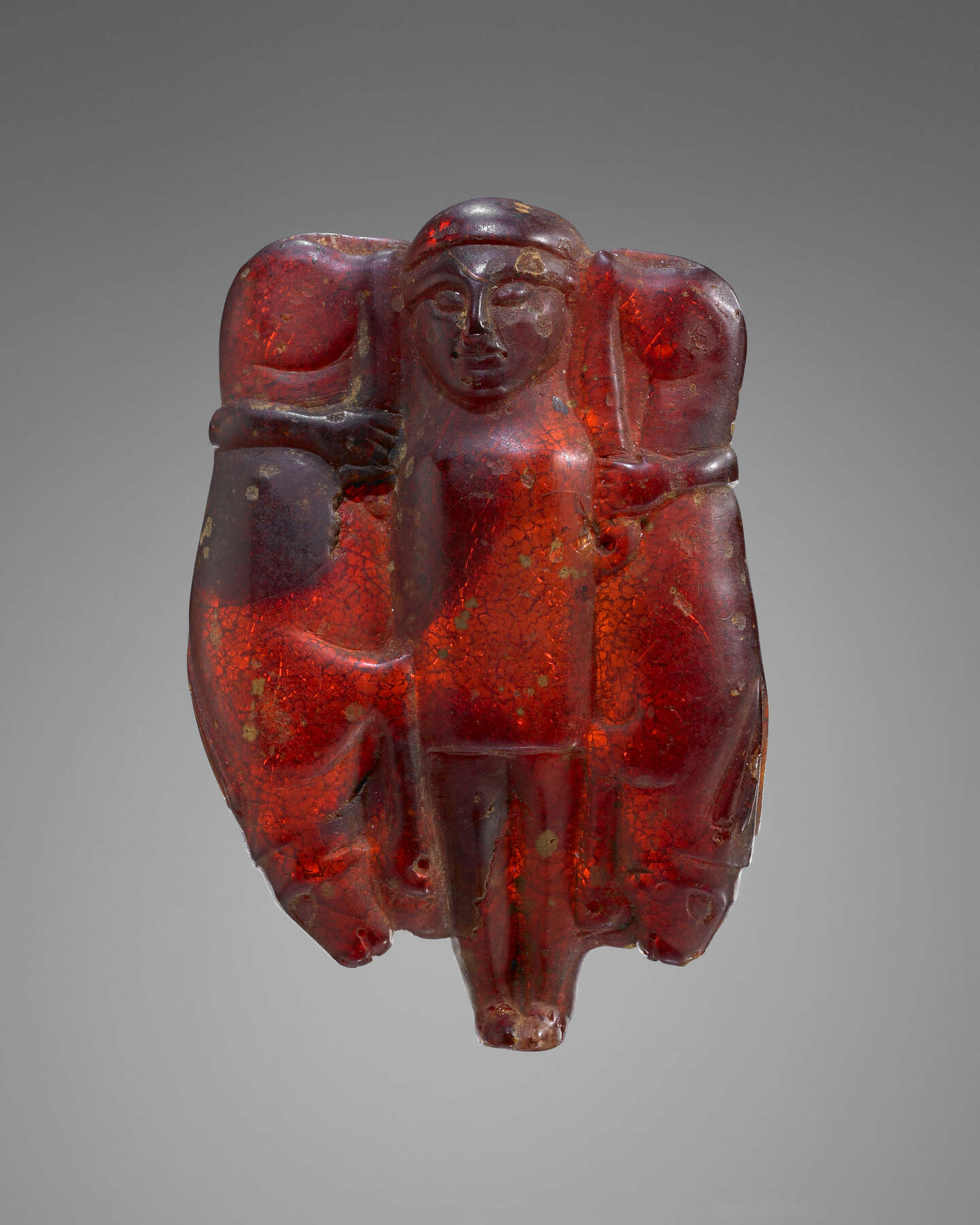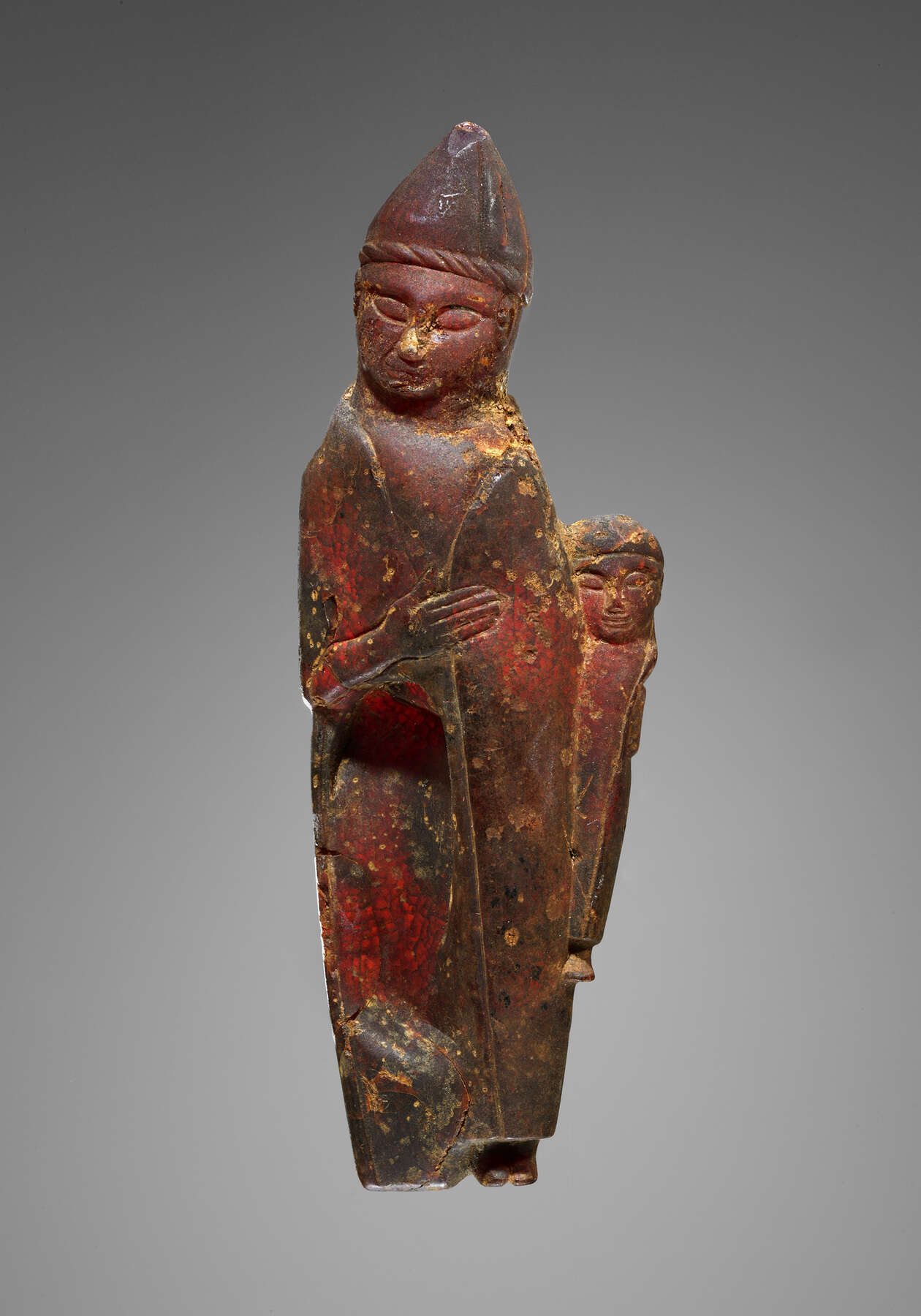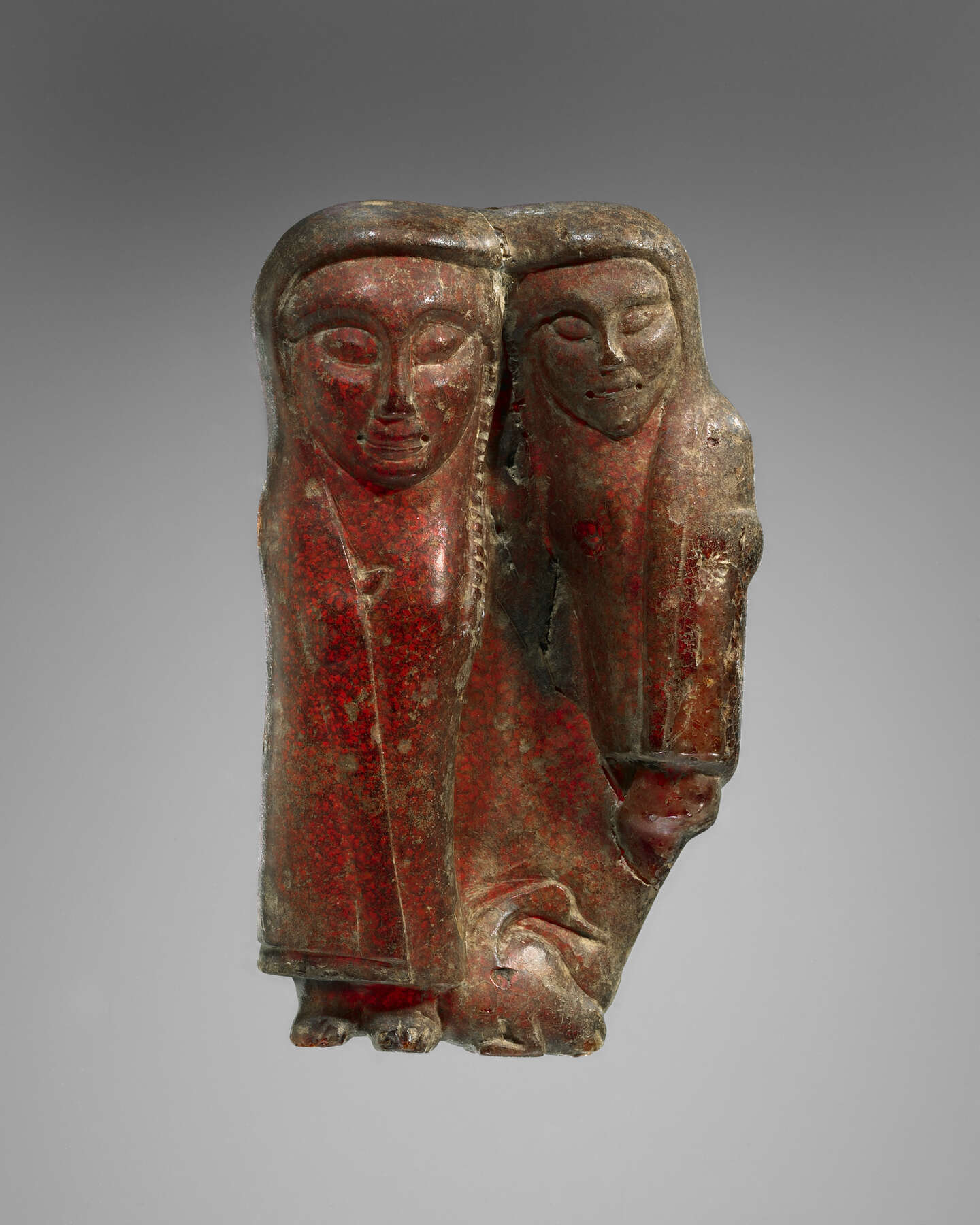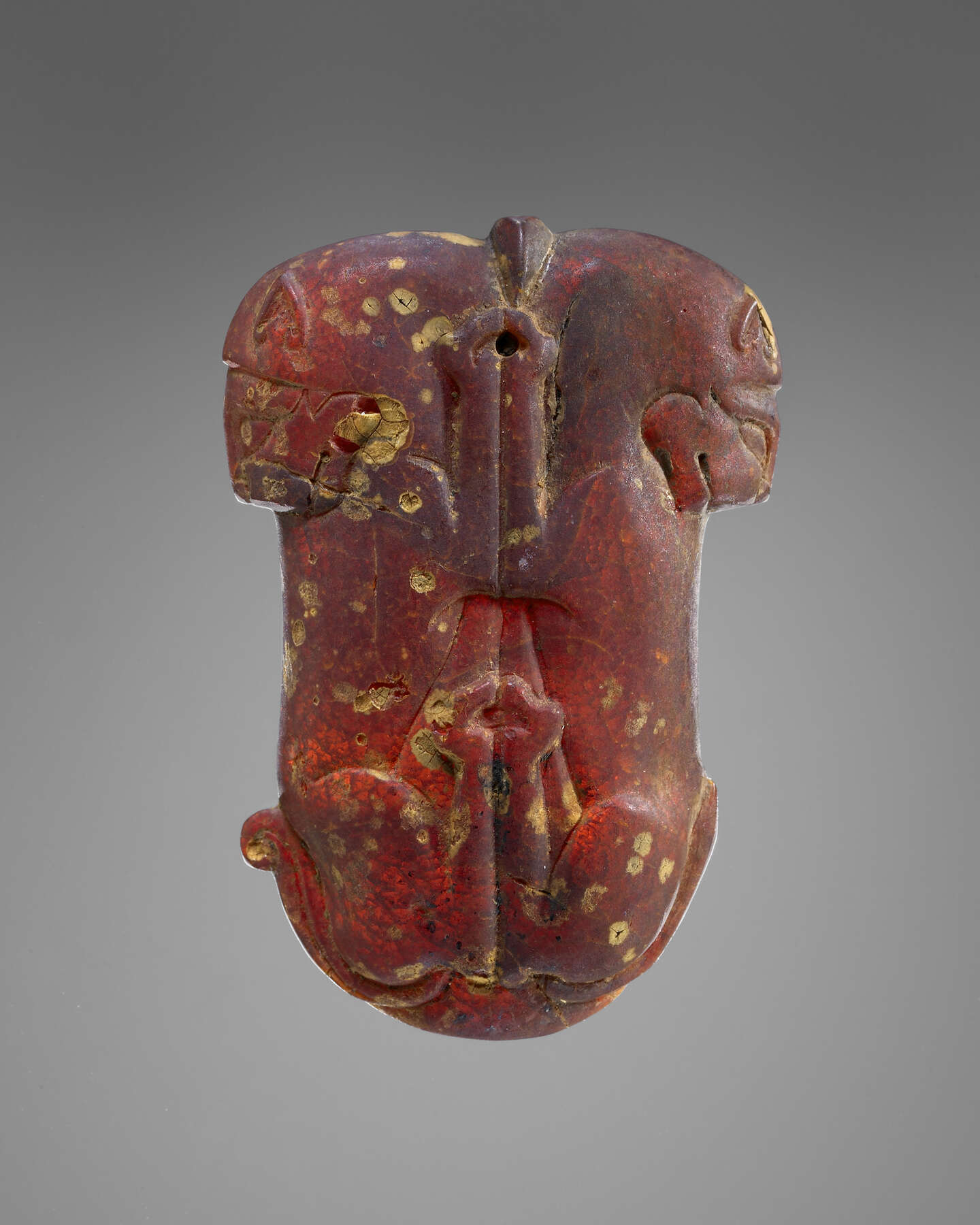5. Pendant: Lion with Swan
| Accession Number | 77.AO.81.2 |
| Culture | Etruscan |
| Date | 600–550 B.C. |
| Dimensions | Height: 42 mm; width: 60 mm; depth: 15 mm; Weight: 25.2 g |
| Subjects | Amulets; Bird; Etruscan culture; Lion |
Provenance
–1977, Gordon McLendon (Dallas, TX), donated to the J. Paul Getty Museum, 1977.
Condition
The pendant is in a good state of preservation, intact with the exception of a chipped portion of the bird’s head and bill. The surface is firm overall, with some abraded areas, minute cracks, overall crazing, and shallow chips. There is little surface deterioration or crust. Shallow chips are missing from the left side of the lion’s jaw, the right front elbow, and the lower edge of the left rear leg. One sizable crack crosses obliquely across the lion’s left shoulder. There are small internal fissures throughout the piece.
The amber is reddish brown. At the modern break on the bird’s head, the interior red-orange color of the material is visible. It is translucent in ambient light, but when subjected to transmitted light, it is transparent and a rich red. Numerous inclusions (or, possibly, deterioration pits) are visible in the lion’s chest, belly, and rump and in the base of the bird’s neck. Before it entered the museum, the pendant is reported to have been lightly cleaned.
Description
This pendant is carved from an oblong piece of amber and is conceived fully in the round. The two main sides are nearly identical. Only the position of the lion’s tail—which descends from the root downward, winds beneath the body and up around the right haunch, and terminates on the right hip—breaks the symmetry of the composition. The bottom surface of the pendant, including the legs and belly, is compressed more than are the two flanks. Between the body and legs on both the underside and the flanks are areas of the pendant without design (to be read as negative space). On the underside, the amber has been sharply cut-in to differentiate between the sunken undersurface and the body parts.
The lion looks back in a complete swivel. Its legs and feet are drawn compactly up under its body, the lower legs and feet stiffly parallel. The legs are angular, thin, and short, contrasting with the compact bulk and round curves of the lion’s head and body. The pads and toes, especially of the back legs, are talon-shaped. The smooth blanket of the lion’s mane is raised away from the face in front, standing up like a crewcut, and falls forward in a semicircular section between the ears. Around the face at the point of juncture of the jaws, the mane juts forward into a cusp of fur. A Z-shaped shallow groove comes to a V above the nose. The folded-back ears have a barely discernible pointed tuft of hair in front and lie well back on the head. The eyes are plastic and almond-shaped, with the outside corners sloping sharply upward. Outlined below by a continuous engraved line, the eyes are set off above by a line that also defines the length of the nose. An extremely fine ridge connects to the cusp. The lion’s mouth is open, exposing the teeth (better preserved on the left side than on the right), including the sharp upper canines, extending down over the lower canines. The lower jaw is suspended squarely under the cheek, emphasizing the stylized, squared-off form of the head; the chin is rounded by the exaggeration of the semicircular flaps.
On the lion’s back, and partly in its mouth, is a long-necked waterbird in the reguardant pose, with its head reverted. The neck is turned back so that the head and bill rest flat on its body. Although the breast of the bird is in the lion’s mouth, the teeth do not indent the flesh. In proportion to the lion, the bird is large. A shallow indentation separates the bird’s body from the large spread of the wing below it. The bird is more precisely rendered on its left side, where the triangular section below the wing (overlapping the lion’s body) is more easily read.
In the area of the juncture of the lion’s face and mane is a smoothed depression, well blended into the design. The perforation holes are the same diameter here as on (cat. no. 4) and the two Kourotrophos pendants, (cat. no. 1) and (cat. no. 2). Located on the right side of the neck is a stopped bore 4 mm in diameter. Engraved lines are visible throughout the piece. On the body, around the lower part of the lion’s head, below the bird’s body, circling the eye, and on the left flank are small hatchings and parallel series of scratch marks. The pendant was bored with a triangular set of perforations, one piercing the thorax from side to side, and one each from the exits of this through-bore to a hole on the front of the neck. When strung, the lion would have been suspended neck upward, with its legs perpendicular to the ground.
Discussion
This pendant has no exact parallel in subject or composition. For the style of the animals and bird, the closest comparisons are the lions of (cat. no. 6), the hares of , the waterbird of , and two amber lions’ heads in the Louvre.1 The squared-up compositional type of 77.AO.81.2 is not uncommon in Etruscan Orientalizing art. It is similar to the faunal compositions found in Etruscan goldwork, in bronze reliefs, and on bucchero. A nearly identical parallel for the amber is the pair of (possible) fibulae molded onto the shoulders of an enthroned canopic figure in Chiusi dated to the second half of the seventh century B.C.2 A close comparison for 77.AO.81.2 is a double lion motif stamped on a number of impasto cup handles from Poggio Civitate (Murlo).3
In spite of its schematic rendering, the bird of 77.AO.81.2 can be classified as a swan and, more specifically, as a mute swan. The salient characteristics are its large size in relation to the lion, its extremely long neck, and the volume of its wing area, but perhaps most important is the diagnostic basal knob on the upper mandible.4 The amber image corresponds to the modern bird as well as to Egyptian illustrations of the mute swan.5 Did the artisan of the pendant know the lion and bird from firsthand knowledge or only from other representations? While there appear to have been no lions in ancient Italy, the mute swan is still a migrant visitor to the area.
The lions of 77.AO.81.2 and and the amber heads in the Louvre are related in style to a large group of archaic Etruscan lions, mainly bronze reliefs, first gathered together by W. L. Brown.6 This large and varied group of lions is characterized by an amalgamation of early Etruscan lion types, which show strong links with the Near East, with Assyrian and Hittite types modified by East Greek stylizations and motif. The lions of the two lion-subject pendants in this group reveal their genealogies. The folded-back ear is a variant of the old Hittite heart-shaped form. The shape and slant of the eyes, the squared-off face, the curve of the lower jaw, and the form of the mane in front reveal their genetic ties with the ferocious lions of Assyria. The East Greek stylizations are brought out by comparison to lions from Ionia.
Two of Brown’s lion groups are more closely related than others to the lions of 77.AO.81.2 and . The first group includes two important parallels: the repoussé-formed lions of two reliefs from a chariot excavated from a “princely” tomb at Castel San Mariano di Corciano.7 The lion’s head of Thetis from the front of the chariot and the lion helmet of Herakles on the side panel are very close matches for the heads of these Getty amber lions. They have in common similar squared-off faces, jaws with deep mandibles, comparably formed eyes, folded-back ears, and smooth manes. The Thetis lion has the same distinctive cusp of the ruff on the cheek found on the lions of 77.AO.81.2 and . The amber lions are also related to the lions of the “Loeb” cauldron from Marsciano in Munich.8 They, too, have this distinctive cheek-ruff tuft. The Castel San Mariano chariot reliefs and the Loeb cauldron and stands reveal the impact of Ionian Greek art, especially that of Samos, as do the lions of 77.AO.81.2 and . The second of Brown’s groups of lion relatives are all lions’ heads, each significantly larger in scale than the pendants. The comparanda include the Etruscan bronze chariot pole decorations and decorative bosses (tomb decorations of some kind) from Vulci and Tarquinia. The closest examples are the lion’s head with inlaid eyes from the Vulcian Tomba del Guerriero, Osteria necropolis, in Rome,9 and the Tarquinian lacunaria in the Castellani collection.10 All the above-listed lions presented here as comparanda are likely to have been manufactured near their findspots in northern internal Etruria11 and date to the last third quarter of the sixth century B.C.12
A lion with prey or parts of a human body grasped in its mouth is an early and important theme in early Greek and Etruscan art, as Brown was the first to outline.13 Two other amber objects in the form of a lion with prey are fibula-bow decorations, one representing a lion attacking a bull, another a lion and a deer or fawn. However, the style and compositions of these are different from 77.AO.81.2, and they are later in date, perhaps from the end of the sixth century B.C.14
A lion savaging a long-necked bird is a rare subject in ancient art. Among the few examples are a Greek Orientalizing earring or temple pendant from Rhodes in the Louvre,15 the aforementioned molded fibulae on the Chiusine “canopic” figure, and a painted detail on a hydria by the Micali Painter in Geneva.16 One of the many variants on the theme is a lion with prey slung over its back; this artistic convention is East Greek in origin.17 77.AO.81.2 appears to be the unique representation in amber.
Although the composition of 77.AO.81.2 may have been instigated in part by the shape of the amber, the squared-up form, with the creatures’ bodies pointing in one direction and the heads in another, may have had special importance. The reverted head, an age-old format in Near Eastern art, perhaps carried something of its earlier signification. For instance, in Kassite-period art, a bird with a turned-back head is found frequently as a divine symbol and attribute.18
The old format of the amber, as well as its character as a shimmering and golden jewel, may have called up the art and ornaments of Egypt and the Near East, and the power and status of the exotic ornaments of the Orient. It may also have called up Odysseus’s famous brooch. If it functioned as an amulet, 77.AO.81.2 might have been able to conjure up the power of the deities of the wild, or the heroes and gods who conquered birds and animals. The lion may even represent symbolically a particular hero or divinity. The symbolism of the swan in the ancient world and in Italy, and specifically its importance to the people who would have seen this amber, deserves further study.
The owner of such an object may have taken on by assimilation the power, bravery, and ferocity of the storied animal and the material as well. On the principle of “like banishing like,” an amber lion amulet might avert terrible danger and protect its owner in life or death. Through amuletic assimilation, a lion-subject amulet might incorporate danger-averting and protective functions for its owner.
The lion of 77.AO.81.2 might have carried deeply embedded cultural meanings such as were known in the Near East. Among the earliest surviving of all ancient Near Eastern amulet types is the lion, and in literature the lion was long the metaphor for warlike kings and fierce deities. In the Neo-Assyrian period, the lion was a “generally magically protective type, known as urgulû.”19 In Egypt, the lion was a symbol of the sun-god Ra, and by extension a symbol of the god Amun. As a desert dweller, the lion was believed to have regenerative capabilities and as such was a vital amulet for the dead. The lion’s conquest of the swan adds to the meaning of the image. If a sixth-century Etruscan lion pendant did to some degree incorporate Mesopotamian or Egyptian symbolism, what better material for it than amber, with its solar associations? In the tomb, the powerful lion, carved from a material long associated with mourning and rebirth, would have made the amulet especially effective for the deceased.
Notes
- . ↩
- For the Chiusine urn, see ; it is illustrated in P. Barcellini, L’Arte Etrusca (Florence, 1958), fig. 14. ↩
- K. M. Phillips, Jr., “Stamped Impasto Pottery Manufactured at Poggio Civitate,” in , pp. 29–46. The number and variety of stamped designs found on pottery and ordinary utensils from northern Etruria during the Orientalizing period are exceptional and closely related to impressions made from cylinder seals. ↩
- Compare the schematic representation of waterbirds in . ↩
- For the mute swan, see , pp. 50–51. The mute swan (Cygnus olor) breeds in parts of Europe, Asia, and southern Africa and winters in parts of Europe, Western Asia, the Middle East, and Africa (ibid., p. 50). “Although not fully understood, it is clear that the swan must have possessed some religious significance which prompted statues of the bird being deposited in the tombs of [three] Dynasty XII princesses” (ibid., p. 51, with references). ↩
- , chap. 5. ↩
- Perugia, Museo Archeologico Nazionale com. 3a, inv. Bellucci 1403 (fragment with the Thetis lion), and com. 453, inv. Bellucci 1427 (panel with a scene with Zeus and Herakles). See A. E. Feruglio and A. Emiliozzi in , pp. 207–25, with earlier bibl.; M. Martelli, “Il ‘Marte’ di Ravenna,” Xenia 6 (1983): 27; M. Martelli, “La cultura artistica,” in Gli Etruschi: Una nuova imagine, ed. M. Cristofani (Florence, 1984), p. 188. P. G. Warden (1984): 87–88, in his review of , cautions against certainty in siting the manufacture since so little is known about the nature of Etruscan workshop production. ↩
- Munich, Antikensammlung SL 68: , passim; , pp. 107–8, fig. 103; W.-G. Thieme, “Die Dreifüsse der Sammlung J. Loeb im Museum für Antike Kleinkunst, München,” Ph.D. diss. (Munich, 1967); and L. Banti, “Bronzi arcaici etruschi: I tripodi Loeb,” in Tyrrhenica: Saggi di studi etruschi, Istituto Lombardo, Accademia di Scienze e Lettere (Milan, 1957), pp. 77–92. ↩
- Museo Nazionale Etrusco di Villa Giulia 63580: , p. 301, no. 11.21.9. ↩
- , pp. 101–4. ↩
- See ibid., p. 89, for his sage evaluation of this material: “This widespread series of styles is undoubtedly Etruscan.… Certain it is that an important source for stylizations and motives was eastern Greece, but it would be a mistake to overemphasize this aspect of these styles.” ↩
- For the date, see , p. 89; and , p. 219. ↩
- For relevant Geometric and Archaic animal-and-prey figurines, see , pp. 57–58; W.-D. Heilmeyer, Frühe olympische Bronzefiguren: Die Tiervotive (Berlin, 1979); and H. G. Buchholz, G. Jörens, and I. Maull, Jagd und Fischfang, Archaeologia Homerica Bd. I, Kap. J (Göttingen, 1973). ↩
- These two amber ornaments are from the same tomb, Belmonte Piceno Tomb 72 (Ancona, Museo Archeologico Nazionale 11014–15): , pl. 30.1–2; , p. 100; , pls. 484–85; and , p. 75, fig. 29. Brown concluded that they were “made on the spot—doubtless by a craftsman who had come from somewhere in Etruria, perhaps from Orvieto or Chiusi,” which remains a valid assessment. ↩
- , pp. 127–37. On p. 129, n. 1, he notes that the pair in the Louvre belong to the same type as a group in the Archaeological Museum, Rhodes, first recorded by G. Jacopi, “Scavi nella necropolis di Jalisso 1924–1928,” Clara Rhodos 3 (1929): 72–80. ↩
- The hydria is in a Geneva private collection: , p. 22, fig. 16. ↩
- , p. 83, observes: “Most modern observers deny that lions carry their quarry in this manner.” For the motif, see the representation on side B of the “white-on-red” ware pithos in the Getty (96.AE.135, gift of Barbara and Lawrence Fleischman): R. De Puma in , United States of America, fasc. 34, The J. Paul Getty Museum, Malibu, fasc. 9 (Malibu, 1996), pl. 470.1, with reference to P. Amandry, “Plaques d’or de Delphes,” 77 (1962): 53–54, pl. 11.1 (Florence 3046), a bucchero pesante oinochoe from Chiusi. ↩
- See, for example, , p. 43. The accompanying inscription on one kudurru probably named the Kassite god Harbe. ↩
- Ibid., p. 119. ↩
Bibliography
- Black and Green 1992
- Black, J., and A. Green. Gods, Demons and Symbols of Ancient Mesopotamia: An Illustrated Dictionary. Austin, TX, 1992.
- Brown 1960
- Brown, W. L. The Etruscan Lion. Oxford, 1960.
- Civiltà degli Etruschi 1985
- Cristofani, M, ed. Civiltà degli Etruschi. Exh. cat. Florence, 1985.
- De Puma and Small 1994
- De Puma, R., and J. P. Small, eds. Murlo and the Etruscans: Art and Society in Ancient Etruria. Madison, WI, 1994.
- Emiliozzi 1997
- Emiliozzi, A., ed. Carri da guerra e principi etruschi. Exh. cat. Viterbo, 1997.
- Gempeler 1974
- Gempeler, R. D. Die Etruskischen Kanopen: Herstellung, Typologie, Entwicklungsgeschichte. Einsiedeln, Switzerland, 1974.
- Höckmann 1982
- Höckmann, U. Die Bronzen aus dem Fürstengrab von Castel San Mariano bei Perugia: Staatliche Antikensammlungen München, Katalog der Bronzen. Vol. 1. Munich, 1982.
- Houlihan 1986
- Houlihan, P. F. The Birds of Ancient Egypt. Warminster, 1986.
- Laffineur 1978
- Laffineur, R. L’orfèvrerie rhodienne orientalisante. Athens, 1978.
- Langdon 1993
- Langdon, S., ed. From Pasture to Polis: Art in the Age of Homer. Exh. cat. Columbia, MO, 1993.
- Marconi 1933
- Marconi, P. “La cultura orientalizzante nel Piceno.” 35 (1933): cols. 265–454.
- Metzger 1991
- Metzger, C. “Noeud d’Héraclès et torsades: Trois bijoux hellénistiques.” Revue du Louvre 41 (1991): 18–23.
- Negroni Catacchio 1989
- Negroni Catacchio, N. “L’ambra: Produzione e commerci nell’Italia preromana.” In Italia, omnium terrarum parens: La civiltà degli Enotri, Chone, Ausoni, Sanniti, Lucani, Brettii, Sicani, Siculi, Elimi, edited by C. Ampolo et al., pp. 659–96. Milan, 1989.
- Rocco 1999
- Rocco, G. Avori e ossi dal Piceno. Rome, 1999.
- Ruuskanen 1992
- Ruuskanen, J.-P. Birds on Aegean Bronze Age Seals: A Study of Representation. Rovaniemi, Finland, 1992.
- Spivey 1987
- Spivey, N. The Micali Painter and His Followers. New York, 1987.
- Sprenger and Bartoloni 1981
- Sprenger, M., and G. Bartoloni. The Etruscans: Their History, Art and Architecture. Translated by R. E. Wolf. Milan, 1981.
